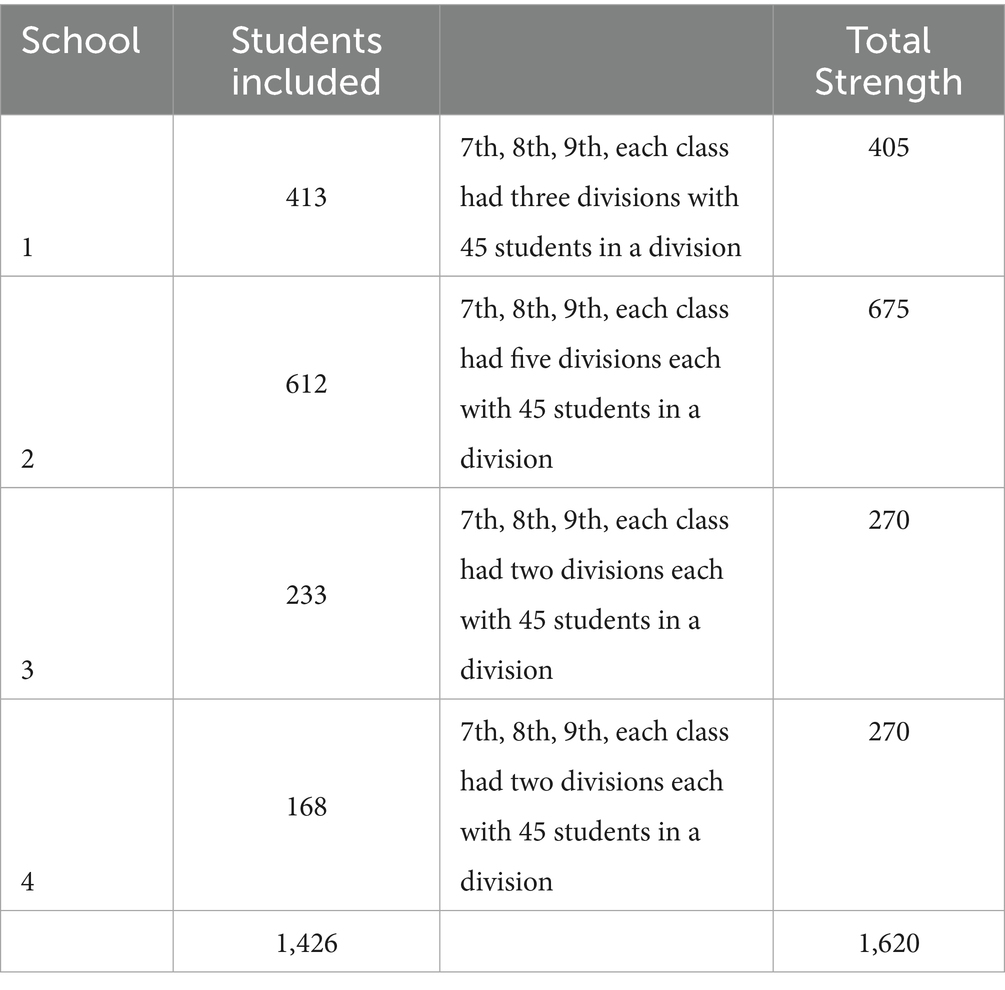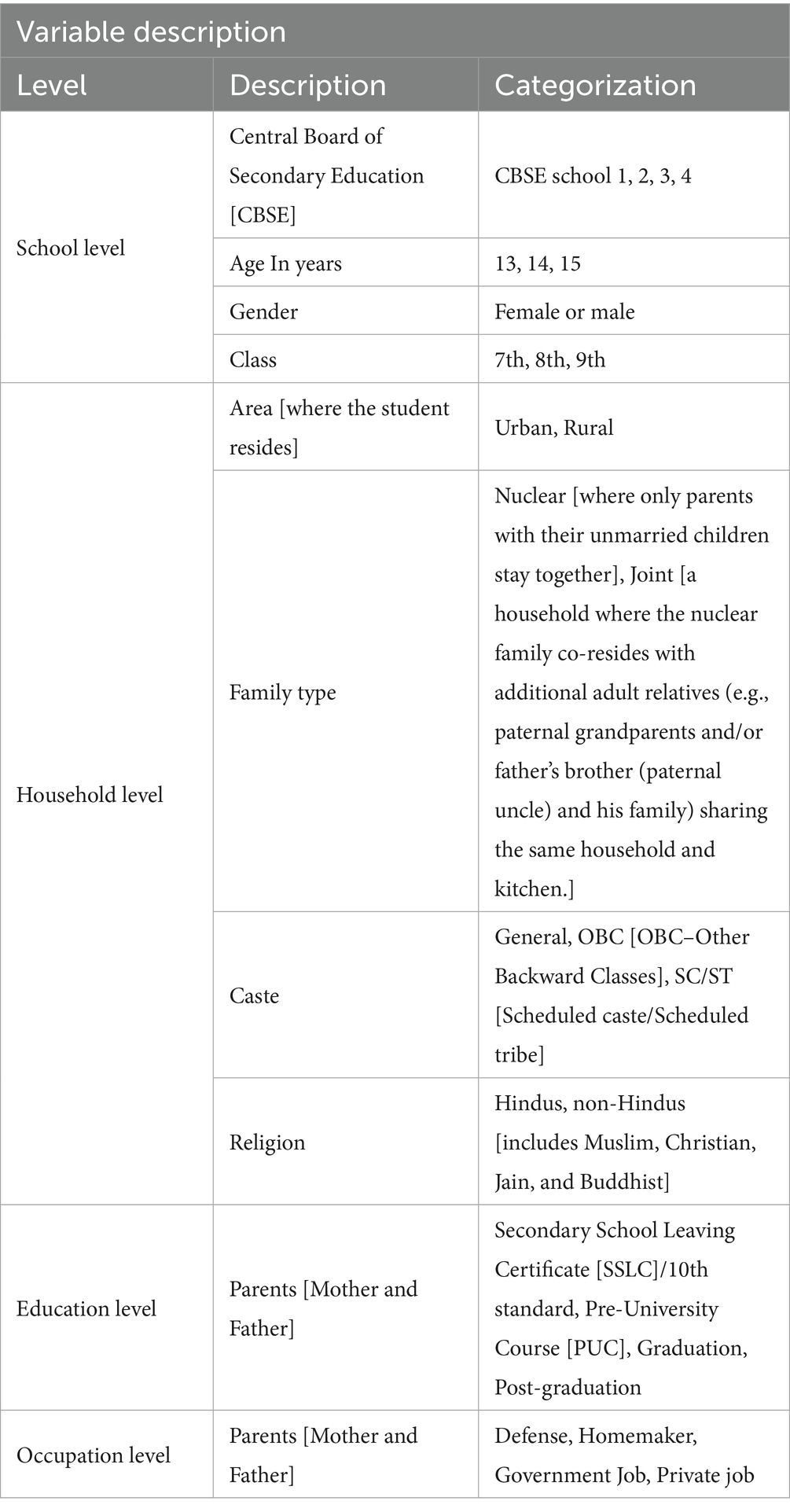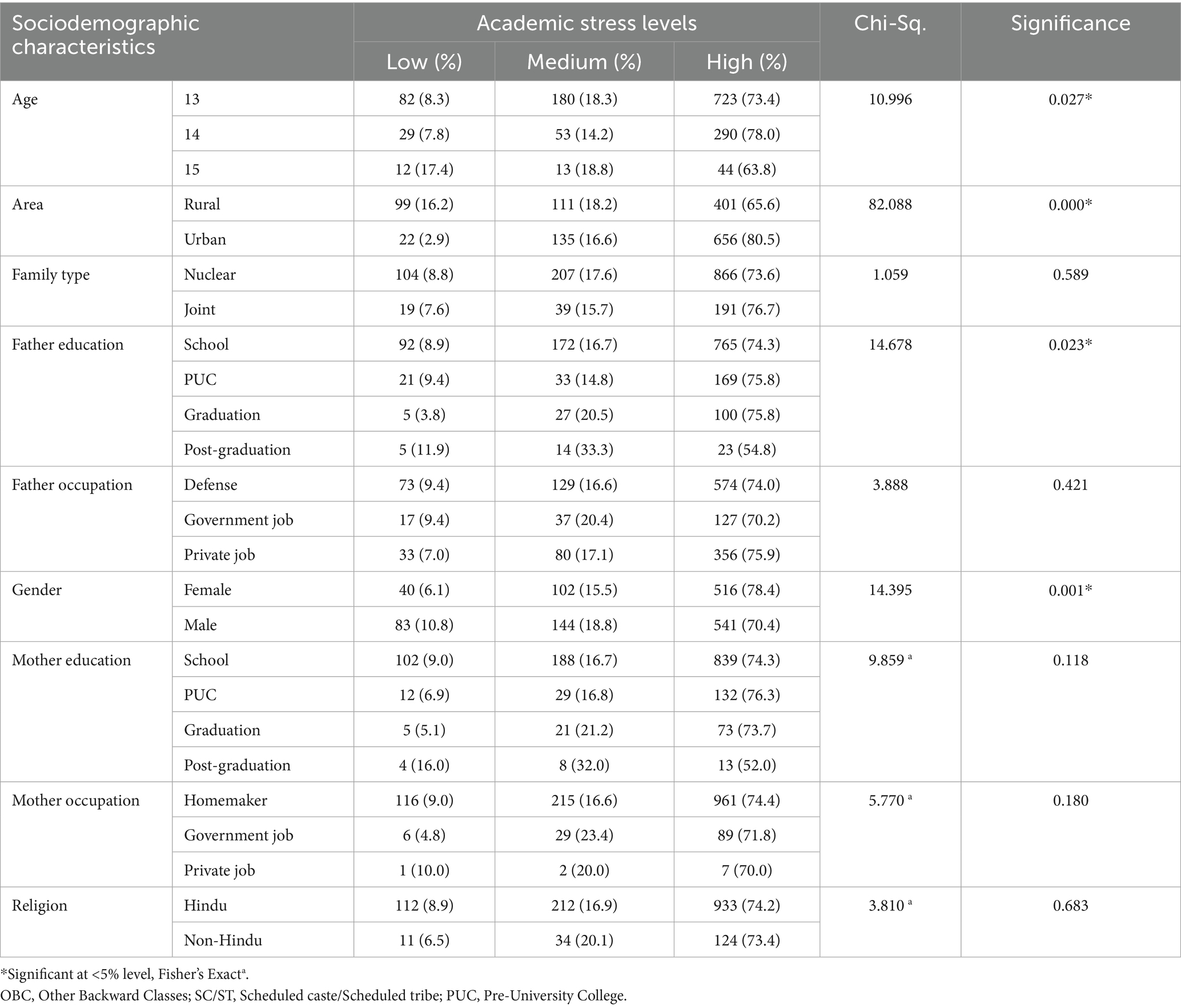- 1Department of Public Health, KLE Jawaharlal Nehru Medical College, Belagavi, Karnataka, India
- 2Department of Psychiatry, KLE Jawaharlal Nehru Medical College, Belagavi, Karnataka, India
- 3Department of Epidemiology and Biostatistics, KLE University, Belagavi, Karnataka, India
Background: Academic stress has emerged as a significant risk factor for mental health development during adolescence. Schools have a considerable influence on adolescents’ development, but increasing academic pressures and social expectations have caused students to experience higher levels of stress, impacting their mental health and overall development.
Objective: To assess academic stress levels and the factors associated with it among students aged 13–15 years in Belagavi district, Karnataka.
Methods: A school-based survey was conducted among 1,426 students from four CBSE schools using universal sampling. Data were collected from July to September 2023. The Educational Stress Scale for Adolescents (ESSA) was used to measure academic stress. Statistical analysis involved Chi-square tests, Fisher’s exact test, and independent t-tests.
Results: Among the 1,426 students, 74% reported high levels of academic stress, with 17% reporting medium levels. Academic stress levels were significantly associated with age (p = 0.027), area (p = 0.000), father’s education (p = 0.023), and gender (p = 0.001). Male students experienced significantly higher stress levels in study pressure, grade-related anxiety, self-expectation, and self-despondency (p < 0.05). Female students experienced slightly higher stress related to workload, though this was not statistically significant.
Conclusion: Academic stress is prevalent among students and is significantly influenced by various sociodemographic variables.
Introduction
Childhood and adolescence are crucial phases for mental health development, with the surrounding environment playing a vital role in shaping overall wellbeing and growth (1). Mental health issues among children and adolescents are a global concern, ranking among the primary causes of death, illness, and disability, particularly in older adolescents. Approximately 50% of mental health disorders begin by age 14, yet the majority remain undiagnosed and untreated (2).
Globally, systematic reviews have highlighted the adverse impact of academic stress on adolescent mental health. A recent review of 52 studies conducted across diverse countries reported that the majority demonstrated a positive association between academic pressure and problems such as anxiety, depression, and even suicidal ideation. Evidence further indicates that stress intensifies in the final years of schooling, with around one in six students experiencing excessive distress (3, 4).
India is home to one-fifth of the global adolescent and youth population, comprising approximately 30% of the country’s total population. According to the National Mental Health Survey 2016, 7.3% of teenagers experienced mental health conditions, with an equal distribution among boys and girls. A study reported that 23.33% of children and teenagers in Indian schools and 6.46% in communities experienced mental health issues (5–8).
Schools, where children spend a substantial portion of their time, have a significant influence on multiple aspects of development. These institutions contribute to shaping peer relationships, social interactions, academic achievement, emotional regulation, and behavioral and moral growth, all of which are closely linked to mental health (9). Consequently, academic stress has emerged as a prominent risk factor for adolescent mental health, with schools being a focal point for both the pressures and opportunities shaping their psychological wellbeing (10).
The growing concern of academic stress, driven by academic demands, personal factors, and social influences, disrupts students’ lives in numerous ways. It impacts their self-esteem, motivation, and behavior, often resulting in an inability to cope with academic challenges and withdrawal from other responsibilities (11). Students face constant pressure to achieve academic success, meet societal expectations, and attain personal goals, some of which may be overly ambitious or unattainable. This intensifies their stress levels, further negatively affecting their mental health (12).
This study is grounded in the Transactional Model of Stress and Coping [TMSC] in which primary and secondary appraisals shape stress response. In the school context, academic stress emerges from a continuous transaction between students and their environment (13). Transactional Model explains how students appraise these conditions—first whether the conditions are challenging [primary appraisal] and second whether they possess sufficient coping resources [secondary appraisal]. Academic Stress increases when perceived school demands outweigh available resources and coping [problem-focused or emotion -focused] is insufficient. Thus, the mechanism is—School environment—[demands, resources]—Appraisal [threat/resources]—coping—academic stress. This study sought to address two key questions—1. What are the levels of academic stress as measured by the Educational Stress Scale for Adolescents [ESSA] and 2. Which sociodemographic characteristics are associated with academic stress levels.
Methods
Study design, area, and period
Eligibility for the school survey analysis was based on a larger randomized controlled mental health intervention trial (RCT) (Clinical Trials Registry of India, CTRI Reg.no CTRI/2023/12/060663). The parent RCT targeted adolescents aged 13–15 years old adolescents, so students in classes 7th–9th from selected Central Board of Secondary Education (CBSE) schools were screened. The study protocol was approved by the KAHER Ethics Committee on Human Subjects for the Ph.D. Research Project (Ref. No. KAHER/EC/22-23/125-2). Data for the current analysis were collected between July and September 2023 in Belagavi district, Karnataka, India.
Population inclusion and exclusion criteria
Students of class seven to ninth who were present on the day of data collection. Those who provided assent, in addition to parental consent and were willing to participate in the study period were included in the study. Students with severe hearing, visual, or communication impairments were excluded.
Sample size determination and sample procedure
Four CBSE schools were selected using purposive sampling, and out of 1,620 students a total of 1,426 students were eligible and were included in the study:
In school one, in class 9, eight students were repeaters.
Data collection instrument and procedure
The first section of the questionnaire included sociodemographic characteristics that provided background information on students and their parents (Table 1). Second section of the questionnaire included the ESSA instrument used to assess academic stress among the students.
Formal permission to use The Educational Stress Scale for Adolescents (ESSA) was obtained from the author. Developed by Sun et al. (28), the ESSA is standardized and validated tool, including validation in studies conducted in India. In the present study, the scale was administered in its original language (English), so no local translation was required.
The ESSA consists of 16 items rated on five-point Likert scale, (16–80) with higher scores indicating greater academic stress. It assesses five factors: Pressure from Study (four items on learning pressure, peer competition, and concerns about the future), Workload (three items on homework and exams), Worry about Grades (three items on grade-related stress), Self-Expectation Stress (three items on unmet expectations), Despondency (three items on academic dissatisfaction) The scale has good internal consistency, with Cronbach’s alpha for the total scale at 0.82 and factor reliabilities ranging from 0.64 to 0.79.
Data entry and statistical analysis
Data were cleaned, coded and entered in MS-Excel and exported to IBM Statistical Package for the Social Sciences (SPSS) version 20.0 for analysis. Sociodemographic data and academic stress levels were summarized by computing frequency and percentages. Academic stress categories were defined based on cut-off score validated in an Indian sample (14).
• Low: Scores −16 to 21
• Medium: Scores 22–42
• High: Scores 42 and above
Associations between academic stress levels and sociodemographic characteristics were assessed using Chi-square tests, with Fisher’s exact test applied when more than 20% of the expected cell count were less than five. Statistical significance was set at a p-value of < 0.05. Differences in mean scores of academic stress-related factors by gender were assessed using independent t-tests, and the assumptions of normality were verified; results were confirmed with Mann–Whitney U tests where appropriate. Multinomial logistic regression was used to identify sociodemographic predictors of academic stress.
Ethical consideration
Before data collection the purpose of the study was clarified to the principal and students of each school. Permission was obtained from the heads of all four schools. Assent and consent were obtained from the students and their parents.
Results
Figure 1 shows the overall academic stress levels among students. It was observed that 74% of students had scored above 42, indicating high levels of academic stress, followed by 17% of students who scored ≤42, indicating medium levels of academic stress.
Table 2 provides the basic characteristics of the school students. Among the 1,426 students, the largest number (69.1%) were 13 years old, with 57.2% coming from urban areas and 82.5% from nuclear families. Most participants’ parents, both fathers (72.2%) and mothers (79.2%), had completed schooling up to the 10th grade. Among the students, 46.1% were female and 53.9% were male. In terms of religion, 88.1% were Hindu. Regarding parents’ occupations, 54.4% of fathers were employed in Defense, and 90.6% of mothers were homemakers.
Table 3 presents the distribution of academic stress levels among students across various sociodemographic characteristics using Chi-square and Fisher’s exact test. Among the various sociodemographic variables assessed, age (p = 0.027), area (p = 0.000), father’s education (p = 0.023), and gender (p = 0.001) were significantly associated with academic stress levels.
Table 4 presents the results of the independent t-test for academic stress factors by gender. Independent t-tests were applied to compare gender differences in academic stress across five categories. Male students exhibited significantly higher stress levels compared to female students in study pressure (M = 13.45, t = 2.649, p < 0.05), grade-related anxiety (M = 11.25, t = 4.386, p < 0.05), self-expectation (M = 10.03, t = 4.218, p < 0.05), and self-despondency (M = 9.27, t = 2.906, p < 0.05). On the other hand, female students reported slightly higher stress related to workload (M = 9.33) compared to male students (M = 9.20), though this difference was not statistically significant (t = −0.848). These results suggest that while academic stress affected both genders, male students reported significantly greater mean scores in academic stress categories.
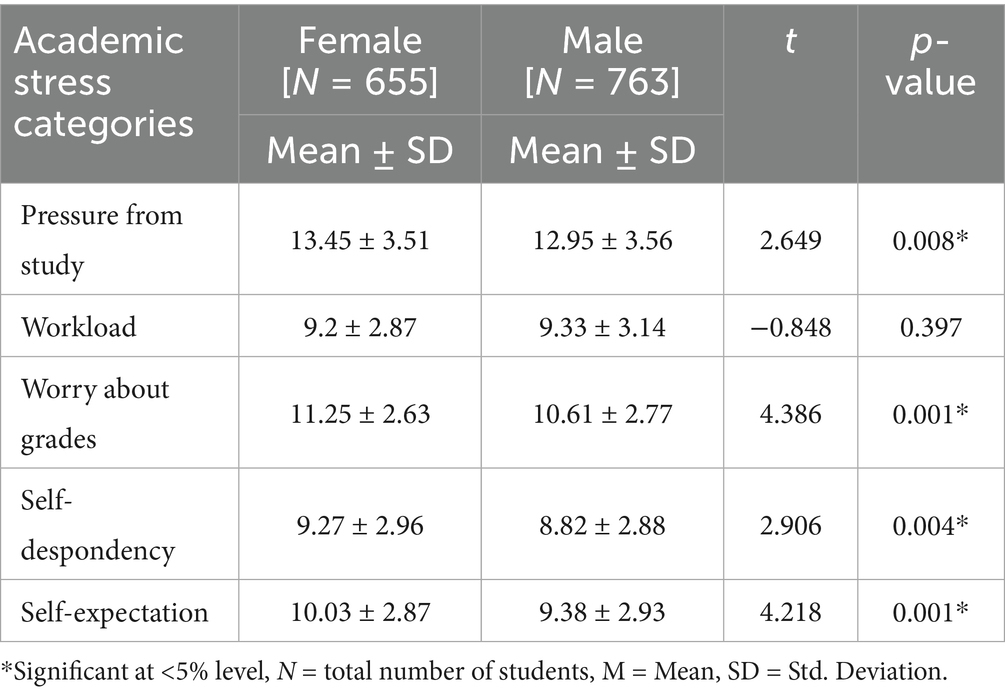
Table 4. Results of independent t-test comparing academic stress categories between male and female students.
Table 5 shows that the regression model was statistically significant (LR χ2 (40) = 247.30, p < 0.001) with Pseudo-R2 of 0.118, indicating that the sociodemographic characteristics accounted for 12% of the variation in academic stress. Academic stress levels increased sharply with grade progression. Compared with 7th graders, students in 8th grade were over 19 times more likely to report medium academic stress level (RRR = 19.26, 95% CI: 7.53–49.26, p < 0.001) and almost 23 times more likely to report high academic stress level (RRR = 22.97, 95% CI: 9.29–56.82, p < 0.001). Those in 9th grade also showed elevated risks, being three times more likely to experience medium stress (Medium: RRR = 3.00, 95% CI: 1.39–6.45; High: RRR = 4.85, 95% CI: 2.42–9.73). Place of residence was another strong predictor. Urban students were six times more likely to report medium stress and nearly 10 times more likely to report high stress compared with rural students (Medium: RRR = 6.30, 95% CI: 3.64–10.91; High: RRR = 9.74, 95% CI: 5.88–16.16; both p < 0.001). Gender differences were also evident, male students had significantly lower odds of reporting both medium and high stress compared with females (RRR = 0.59, 95% CI: 0.36–0.97, p = 0.037) or High stress categories (RRR = 0.42, 95% CI: 0.27–0.65, p < 0.001). Caste and family structure showed more specific associations. Students from OBC backgrounds and those from joint families were significantly more likely to experience high stress compared with their peers. High stress, OBC caste (RRR = 2.43, 95% CI: 1.10–5.38, p = 0.028) and joint family type (RRR = 2.07, 95% CI: 1.13–3.76, p = 0.018). Other variables including religion, parental education, parental occupation was not independently associated with academic stress levels after adjustment.
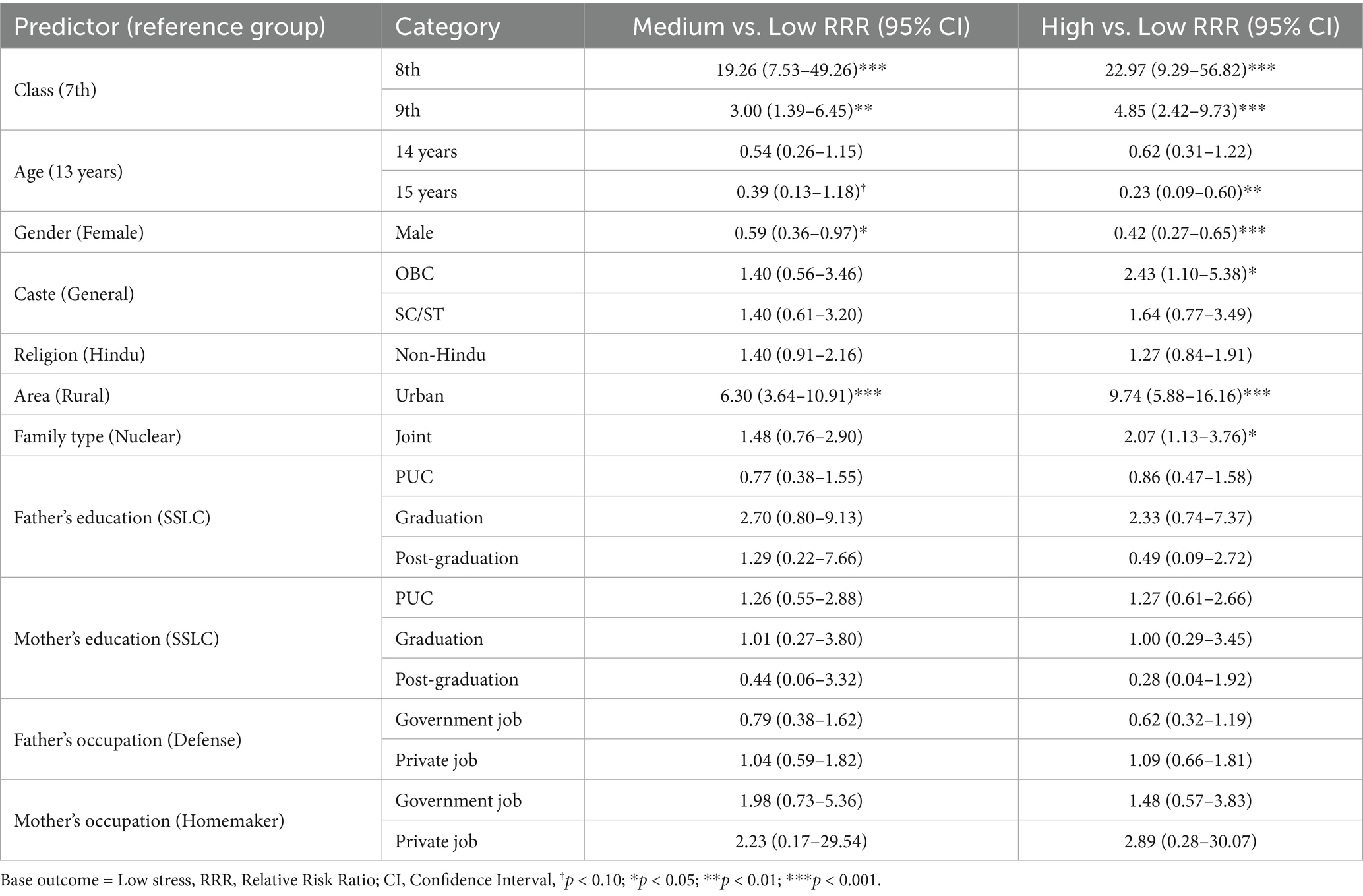
Table 5. Multinomial logistic regression of sociodemographic predictors of academic stress levels among adolescents (N = 1,426).
Discussion
This study assessed academic stress levels and associated factors among 1,426 (13–15 years) using the Educational Stress Scale for Adolescents (ESSA). We observed that 74% scored above 42 (high stress) and 17% fell in the medium range (Figure 1). In adjusted multinomial models (Table 5) grade progression (8th/9th vs. 7th) and urban residence were the strongest predictors of elevated stress, while boys had lower adjusted odds of medium/high academic stress than girls despite scoring higher than girls on specific academic stress factors (study pressure, grade anxiety, self-expectation, despondency) in t-tests (Table 4). Additional associations were observed for caste (OBC) and joint family structure showed positive associations with high academic stress, whereas parental education and occupation were not independently related to academic stress levels after the adjustment.
How our prevalence compares and why it is high
The prevalence documented here exceeds compared to several earlier studies. For example, a work using ESSA along with KADS found only 22% of students in the high stress category (15), case–control studies have often restricted stress t cases while controls reported mild stress (16). Studies relying on SAAS or PAS scales typically show 31–48% of students experiencing high or moderate stress, often with subscale gender differences in workload or time restraints, but weaker overall associations with performance (17). A pattern replicated in newer Indian cohorts where overall sex differences may be small but subscale contrasts persist (18). In India, academic achievement is deeply entwined with parental expectations and exam based progression. Urban students, are embedded in environments where private tutoring, high stakes assessments, and peer competition are common. Yet school mental health support remains limited or uneven (19). Studies of competitive exam contexts similarly document high academic stress, high perceived parental pressure, and low wellbeing, are widespread across streams and classes when systematic pressure dominates (20). Together these structural features offer a plausible explanation for the particularly high levels observed in our study, especially in urban and higher-grade students.
Interpreting sociodemographic variables through the transactional model
The Transactional Model of stress and coping (13) helps in understanding the sociodemographic patterns observed. Academic stress arises when the students appraise school demands such as exams, assignments and other activities exceed their available resources like time, support and coping strategies. For many, especially in urban settings and higher grades, these demands are perceived as threats rather than challenges. Contemporary evidence in younger secondary grades show that academic stress directly increases cognitive, emotional, and behavioral components of burnout, with anxiety acting as a key mediator, while self-efficacy buffers against these effects (21). Response surface work further reveal that when both academic pressure and psychological imbalance are high, the risk of depressive symptoms is amplified, with effects largest in pivotal exam years (22). This aligns with our multinomial findings, where 8th and 9th graders have higher odds of academic stress compared with their 7th grade peers, suggesting an early escalation of threat appraisals in the school settings.
Gender–reconciling t-test and regression
Our gender findings highlight the complexity of academic stress experiences. First, boys scored higher than girls on study pressure, grade anxiety, self-expectation, and despondency (Table 4), consistent with factor-level sex contrasts reported on PAS and SAAS subscales (17, 18). Second, in the adjusted multinomial models, boys had lower odds of medium/high overall academic stress than girls. This contradiction is expected when domain specific elevations among boys do not translate into higher overall academic stress classifications once grade, urban residence and family factors are considered. Moreover, academic stress may manifest in divergent behavioral outcomes. For instance, recent work shows that social involvement can rise as a coping channel when academic emotions are low (23). These observations suggest that interventions should be sensitive to factor specific vulnerabilities—addressing grade related anxiety and self-expectations in boys while recognizing that, overall girls remain at higher risk for medium to high academic stress.
Family/school processes vs. distal socioeconomic characteristics
While preliminary analyses hinted at associations between parental education and academic stress (Table 3), but these links decreased after adjustments. This is consistent with the evidence that proximal process—the nature of parental involvement and the quality of school climate are more influential than the distal socioeconomic markers. Supportive, autonomy–enhancing parental involvement has been shown to reduce internalizing symptoms, whereas parental pressure and psychological control tend to heighten stress, with the latter often exerting a stronger negative effect than the protective influence of involvement (24). School level factors such as classroom management. Teacher support, and school connectedness similarly shape adolescents’ experiences of stress and wellbeing (25). These insights help why parental education and occupation variables can lose explanatory power once grade, urban context and family functioning styles are accounted for.
Mechanisms linking academic stress to mental health risks
Longitudinal evidence underscores the pathways through which academic stress translates into mental health problems. Sleep disturbances and loneliness have been identified as major mediators linking stress to depression and anxiety, while physical activity contributes modestly and inconsistently across outcomes (26). Importantly, time spent studying does not directly predict emotional outcomes but rather exerts its influence through student’s perceptions of stress, reinforcing the central role of appraisal in the Transactional Model (13). In or urban, high grade subgroup, where demands and comparison are dens, these mediators likely intensify the risk. There is also evidence that enhancing self-efficacy can weaken the stress [the stress → anxiety → burnout] (27) highlighting a need for interventions for schools.
Positioning our findings in the wider Indian context
Narrative syntheses of Indian school mental health emphasize cultural valuation of grades, stigma of failure and heavy reliance on private tutoring with reports of substantial exam anxiety in board years (19). Studies in competitive exam cohorts likewise document high stress and high parental pressure across streams, with degraded wellbeing (20). Our findings that urban students with those in higher grades bear the greatest burden are consistent with these realities. The additional associations with caste and family structure likely reflect underlying social roles and household expectations that shape adolescents appraisals and coping opportunities. Disparities in prevalence estimates across studies such as lower rates reported with SAAS or PAS (15, 17) are best understood as function of differences in scale content, cut off, sample characteristics and timing, particularly with post-COVID-19 cohorts (15–18).
Limitations
Among the several limitations of this study are: As this was a cross-sectional study, no casual or temporal relationships can be inferred from the study findings. The type of school [CBSE] and the purposive sampling of school limit the generalizability of findings to other school boards or government schools. The study involved self-reported scale on academic stress, no other psychological and social stressors were studied, which could interact with academic stress.
Conclusion
This study reveals a high prevalence of academic stress among adolescents of CBSE schools, Belagavi, Karnataka, with grade progression and urban residence, being the strongest determinants. Female sex, OBC caste and joint family structure were also the significant predictors, underscoring how rising academic demands and limited coping resources contribute to stress. These findings interpreted through Transactional Model of stress and coping, highlight the role of school demands and social context in shaping stress among adolescents. It is recommended that management and the teachers need to sensitize the students the importance of school counselor and how they can be benefited from the counseling. Mental health club for Students should be formed so that students can actively participate in fun learning activities based on mental health.
Data availability statement
The original contributions presented in the study are included in the article/supplementary material, further inquiries can be directed to the corresponding author.
Ethics statement
The studies involving humans were approved by the KAHER Ethics Committee on Human Subjects (Ref. No. KAHER/EC/22-23/125-2). The studies were conducted in accordance with the local legislation and institutional requirements. Permission was obtained from the heads of all four schools. Written informed consent for participation in this study was provided by the participants’ legal guardians/next of kin.
Author contributions
SH: Conceptualization, Methodology, Visualization, Project administration, Validation, Software, Formal analysis, Resources, Writing – original draft, Data curation, Investigation, Writing – review & editing. MA: Supervision, Writing – review & editing, Methodology, Conceptualization, Writing – original draft, Investigation, Visualization, Project administration, Validation, Resources. VK: Validation, Methodology, Writing – review & editing, Supervision, Project administration, Conceptualization, Writing – original draft, Resources, Visualization. DO: Resources, Methodology, Validation, Writing – original draft, Writing – review & editing, Data curation, Investigation. AC: Validation, Writing – review & editing, Methodology, Formal analysis, Resources, Writing – original draft, Data curation, Software, Visualization.
Funding
The author(s) declare that no financial support was received for the research and/or publication of this article.
Acknowledgments
We would like to express our gratitude to all the school principals and staff for their continuous support and to the students who participated in the study. We also thank Anil Kumar for his support.
Conflict of interest
The authors declare that the research was conducted in the absence of any commercial or financial relationships that could be construed as a potential conflict of interest.
Generative AI statement
The authors declare that Gen AI was used in the creation of this manuscript. For grammar check and for summarization writing ideas. We acknowledge the use of AI tool [ChatGPT-5] for overall grammar check and formatting referencing list.
Any alternative text (alt text) provided alongside figures in this article has been generated by Frontiers with the support of artificial intelligence and reasonable efforts have been made to ensure accuracy, including review by the authors wherever possible. If you identify any issues, please contact us.
Publisher’s note
All claims expressed in this article are solely those of the authors and do not necessarily represent those of their affiliated organizations, or those of the publisher, the editors and the reviewers. Any product that may be evaluated in this article, or claim that may be made by its manufacturer, is not guaranteed or endorsed by the publisher.
References
1. World Health Organization. Child and adolescent mental and brain health. Geneva: World Health Organization (2022).
3. Steare, T, Muñoz, CG, Sullivan, A, and Lewis, G. The association between academic pressure and adolescent mental health problems: a systematic review. J Affect Disord. (2023) 339:302–17. doi: 10.1016/j.jad.2023.07.028
4. Wuthrich, VM, Jagiello, T, and Azzi, V. Academic stress in the final years of school: a systematic literature review. Child Psychiatry Hum Dev. (2020) 51:986–1015. doi: 10.1007/s10578-020-00981-y
5. United Nations Population Fund (UNFPA). A profile of adolescents and youth in India. New Delhi: UNFPA India (2016).
6. Duggal, C, Kataria, K, Murali, Y, Anand, A, Ramasuri, R, Joseph, S, et al. Government initiatives in school mental health in India: a landscape report. Bengaluru: Sattva Consulting (2024).
7. Malhotra, S, and Patra, BN. Prevalence of child and adolescent psychiatric disorders in India: a systematic review and meta-analysis. Child Adolesc Psychiatry Ment Health. (2014) 8:22. doi: 10.1186/s13034-017-0175-2
8. Gururaj, G, Varghese, M, Benegal, V, Rao, GN, Pathak, K, Singh, LK, et al. National mental health survey of India, 2015–16: prevalence, patterns, and outcomes. Bengaluru: National Institute of Mental Health and Neuro Sciences (2016).
9. Fazel, M, Hoagwood, K, Stephan, S, and Ford, T. Mental health interventions in schools in high-income countries. Lancet Psychiatry. (2014) 1:377–87. doi: 10.1016/S2215-0366(14)70312-8
10. Maleki, A, Faghihzadeh, E, Youseflu, S, and Barjasteh, SZ. Socio-economic inequalities in health-related quality of life among Iranian young people in middle adolescence: application of the health equity assessment toolkit. BMC Pediatr. (2023) 23:16. doi: 10.1186/s12887-022-03815-z
11. Geronimo, SM, Hernandez, AA, and Abisado, MB. Academic stress of students in higher education using machine learning: a systematic literature review In: IEEE 13th international conference on system engineering and technology; 2023 Oct 2–3; Shah Alam, Malaysia. Piscataway (NJ): IEEE (2023). 141–6.
12. Singh, BP. Study and analysis of academic stress of B.Ed. students. Int J Educ Plan Adm. (2011) 1:119–27.
13. Kivak, R. Transactional model of stress and coping. EBSCO Research Starters (2024). Available online at: https://www.ebsco.com (Accessed September 24, 2025).
14. Sarma, H, and Bordoloi, B. A correlational study on academic stress and self-esteem of students from higher secondary schools of Guwahati City. Indian J Psychiatr Nurs. (2018) 15:4. doi: 10.4103/2231-1505.262449
15. Pillai, J, Jose, S, Velukutty, BA, and Riyaz, A. Academic stress and coping in high school adolescents. Int J Contemp Pediatr. (2023) 10:153–7. doi: 10.18203/2349-3291.ijcp20230027
16. Razia, B, and Naushad, R. Academic stress of adolescents in government and private schools. Int J Sci Res. (2016) 5:141–4.
17. Sarfika, R, Saifudin, IMM, Malini, H, Effendi, N, and Wenny, B. Peer pressure and academic stress among junior high school students: a cross-sectional study. Front Nurs. (2024) 11:191–9. doi: 10.2478/fon-2024-0020
18. Rure, D, Kaithwas, N, Singh, R, and Shakya, M. Academic stress in high school students during the transition from online to offline exams: a retrospective study from the post-COVID-19 era. Indian J Psychiatry. (2023) 32:S231–5. doi: 10.4103/ipj.ipj_231_23
19. Deb, S, and Deb, S. Mental health status of school students in India: the role of school-based family counselling. J Psychol Couns Sch. (2025) 35:78–88. doi: 10.1177/20556365251321202
20. Pienyu, K, Margaret, B, and D’Souza, A. Academic stress, perceived parental pressure, and anxiety related to competitive entrance examinations and general well-being among adolescents: a cross-sectional survey from Karnataka, India. J Educ Health Promot. (2024) 13:474. doi: 10.4103/jehp.jehp_2094_23
21. Xing, J. A conceptual model of adolescents’ attachment and resilience to daily stressors: implications for the COVID-19 normalization period and afterwards. Psychiatr Danub. (2022) 34:743–51. doi: 10.24869/psyd.2022.743
22. Ye, Y, Zhang, Z, Tao, Z, Liping, C, Wang, Y, Chen, H, et al. Academic pressure and psychological imbalance in high school students: predictors of depression via polynomial regression and response surface analysis. Psychol Res Behav Manag. (2025):15–23. doi: 10.2147/PRBM.S498606
23. Charan, IA, Chongjin, W, and Soomro, S. The relationship between academic stress, anxiety, and cognitive behavioral outcomes among young adults: the moderating role of prosocial behavior. Acta Psychol. (2025) 258:105234. doi: 10.1016/j.actpsy.2025.105234
24. Xue, L. The impact of secondary school students’ perceptions of parental academic involvement and academic stress on internalizing problem behaviors: the mediating roles of psychological resilience and materialism. Front Psychol. (2025) 16:1582493. doi: 10.3389/fpsyg.2025.1582493
25. Mandal, AK, and Talesara, S. A study of reducing student stress in classrooms in India. Elem Educ Online. (2023) 20:4217–23.
26. Wang, J, Wang, Z, Yang, Y, Wang, T, Lin, H, Zhang, W, et al. Academic burden and emotional problems among adolescents: a longitudinal mediation analysis. J Adolesc. (2025) 97:989–1001. doi: 10.1002/jad.12471
27. Gao, X. Academic stress and academic burnout in adolescents: a moderated mediating model. Front Psychol. (2023) 14:1133706. doi: 10.3389/fpsyg.2023.1133706
Keywords: academic stress, adolescents, school, students, India, educational stress, ESSA
Citation: Haritay S, Angolkar M, Koparde V, Oswal D and Carvalho A (2025) Academic stress in adolescents: findings from a school-based study in Belagavi district. Front. Public Health. 13:1631136. doi: 10.3389/fpubh.2025.1631136
Edited by:
Víctor Arufe Giráldez, University of A Coruña, SpainReviewed by:
Oliver Ramos-Alvarez, University of Cantabria, SpainDheerendra Mishra, Government Medical College Satna, India
Copyright © 2025 Haritay, Angolkar, Koparde, Oswal and Carvalho. This is an open-access article distributed under the terms of the Creative Commons Attribution License (CC BY). The use, distribution or reproduction in other forums is permitted, provided the original author(s) and the copyright owner(s) are credited and that the original publication in this journal is cited, in accordance with accepted academic practice. No use, distribution or reproduction is permitted which does not comply with these terms.
*Correspondence: Shivani Haritay, c2hpdmFuaWhhcml0YXlAZ21haWwuY29t
 Shivani Haritay
Shivani Haritay Mubashir Angolkar
Mubashir Angolkar Vinayak Koparde
Vinayak Koparde Deshna Oswal
Deshna Oswal Alex Carvalho
Alex Carvalho